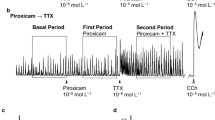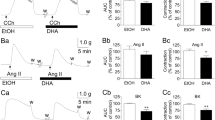Abstract
These studies were performed to examine whether prostaglandin E2 stimulates intestinal epithelial secretion via a receptor-mediated or non-receptor-mediated activation of adenylate cyclase. Solubilization of epithelial cell adenylate cyclase with Lubrol PX, which separates the receptor moiety of the cyclase from the remainder of the complex, inhibited the prostaglandin E2 stimulation of the cyclase. A similar result was obtained with VIP, which activates adenylate cyclase via a receptor-mediated mechanism, whereas fluoride, γS-GTP, and forskolin, which activate the cyclase via non-receptor-mediated mechanisms, all stimulated solubilized adenylate cyclase. In addition, prostaglandin E2 and VIP both showed a dependence on GTP for adenylate cyclase stimulation while fluoride and forskolin did not. These data suggest that prostaglandin E2 activates intestinal mucosal adenylate cyclase by a receptor-mediated mechanism. The presence of such receptors lends support to the possibility that prostaglandins have a physiological role in the control of mucosal transport.
Similar content being viewed by others
References
Matuchansky C, Bernier JJ: Effects of PGE1 on glucose, water and electrolyte absorption in the human jejunum. Gastroenterology 64:1111–1118, 1973
Knapp HR, Oelz O, Sweetman BJ, Oates JA: Synthesis and metabolism of prostaglandins E2, F2α and D2 by the rat gastrointestinal tract. Stimulation by a hypertonic environmentin vitro. Prostaglandins 15:751–757, 1978
Le Duc LE, Needleman P: Regional localization of prostaglandin and thromboxane synthesis in dog stomach and intestinal tract. J Pharmacol Exp Ther 211:181–188, 1979
Smith GS, Warhurst G, Turnberg LA: Synthesis and degradation of prostaglandin E2 in epithelial and subepithelial layers of the rat intestine. Biochim Biophys Acta 713:684–687, 1982
Beubler E, Lembeck F: Inhibition by morphine of prostaglandin E1-stimulated secretion and cyclic adenosine 3′, 5′-monophosphate formation in the rat jejunumin vivo. Br J Pharmacol 68:513–519, 1980
Kimberg DV, Field M, Johnson J, Henderson A, Gershon E: Stimulation of intestinal mucosal adenylate cyclase by cholera enterotoxin and prostaglandins. J Clin Invest 50: 1218–1230, 1971
Murer H, Aumann E, Biber J, Hopfer U: The surface membrane of the small intestinal epithelial cell. I. Localization of adenylate cyclase. Biochim Biophys Acta 433:509–519, 1976
Lowry OH, Rosebrough NJ, Farr AL, Randall PJ: Protein measurement with the Folin phenol reagent. J Biol Chem 193:265–275, 1951
Guillon G, Roy C, Jard S: A systematic study of effects of nonionic detergent, on solubilization and activity of pig kidney adenylate cyclase. Eur J Biochem 92:341–348, 1978
Rodbell M: The role of hormone receptors and GTP-regulatory proteins in membrane transduction. Nature 284:17–22, 1980
Seamon K, Daly JW: Activation of adenylate cyclase by the diterpene forskolin does not require guanine nucleotide regulatory protein. J Biol Chem 256:9799–9801, 1981
Amiranoff B, Laburthe M, Rosselin G: Characterization of specific binding sites for vasoactive intestinal peptide in rat intestinal epithelial cell membranes. Biochim Biophys Acta 627:215–224, 1980
Tepperman BL, Soper BD: Distribution of PGE2 binding sites in the porcine gastrointestinal tract. Prostaglandins 22:205–212, 1981
Bukhave K, Rask-Madsen J: Saturation kinetics applied toin vitro effects of low prostaglandin E2 and F2α concentrations on ion transport across human jejunal mucosa. Gastroenterology 78:32–42, 1980
Limbird LE, Lefkowitz: Resolution of β adrenergic receptor binding and adenylate cyclase activity by gel exclusion chromatography. J Biol Chem 252:799–802, 1977
Haga T, Haga K, Gilman: Hydrodynamic properties of the β-adrenergic receptor and adenylate cyclase from wild type and variant S49 lymphoma cells. J Biol Chem 252:5776–5782, 1977
Rodbell M, Birnbaumer L, Pohl S, Krans HMJ: The glucagon-sensitive adenylate cyclase system in plasma membranes of rat liver. J Biol Chem 246:1877–1882, 1971
Ross EM, Maguire ME, Sturgill TW, Biltonen RL, Gilman AG: Relationship between the β-adrenergic receptor and adenylate cyclase. J Biol Chem 252:5761–5775, 1977
Author information
Authors and Affiliations
Rights and permissions
About this article
Cite this article
Smith, G., Warhurst, G., Lees, M. et al. Evidence that PGE2 stimulates intestinal epithelial cell adenylate cyclase by a receptor-mediated mechanism. Digest Dis Sci 32, 71–75 (1987). https://doi.org/10.1007/BF01296690
Received:
Revised:
Accepted:
Issue Date:
DOI: https://doi.org/10.1007/BF01296690




